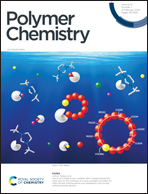A fully bio-based Schiff base vitrimer with self-healing ability at room temperature†
Abstract
The design of a green and renewable bio-based self-healing vitrimer has attracted extensive attention due to the increasing emphasis on an environment friendly society. However, it remains a challenge to design and fabricate a fully bio-based vitrimer with a room temperature self-healing ability without sacrificing the aqueous stability and mechanical performance. In this work, a dialdehyde monomer was designed and synthesized using vanillin, 2,5-furandicarboxylic acid, and succinic acid. A fully bio-based Schiff base vitrimer was prepared with the bio-based curing agent Priamine 1071 (FDV-1071 and SCV-1071). The synthetic process was simple under mild conditions at room temperature without any catalyst. The rigid polyphenyl and furan structure of the dialdehyde monomer endowed the vitrimer with reinforced mechanical performance, and the tensile strength and Tg of FDV-1071 reached 2.45 MPa and 25.14 °C, respectively. The fully bio-based vitrimer containing both an imine bond and an active ester bond showed excellent thermal reversibility and self-healing properties. FDV-1071 slices allowed multiple reprocessing cycles at 120 °C and 10 MPa and still retained the self-healing ability even at room temperature. In addition, the aliphatic chains of Priamine 1071 increased the hydrophobicity of the vitrimer, greatly enhancing the stability in the aqueous environment, and the degradability of the vitrimer was tunable by the introduction of an organic solvent.

- This article is part of the themed collection: Polymer Chemistry 15th anniversary regional spotlight collection: China


 Please wait while we load your content...
Please wait while we load your content...